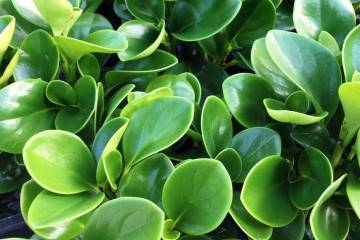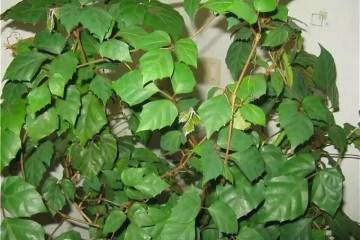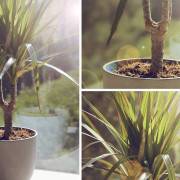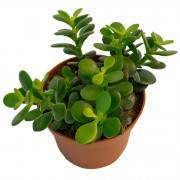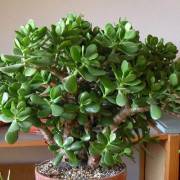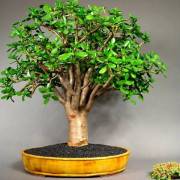Wood's ceropegia - home care
Content:
Ceropegia woodii belongs to the Apocynaceae family. It got its name for the unusual shape of flowers: "ceropegia" in translation from Greek "candelabrum". It is a perennial herb with tuberous roots, original flowers that look like miniature candles and rounded thickened leaves with a marble color. The stem of this succulent is curly, so that in nature it can grow on rocky surfaces, and at home, thanks to this feature, it is used as an ammo decoration for an apartment or office.
Homeland of the plant
In the wild, these succulents grow along the tropics - in India, southern Africa, China, the sulfur of Australia, and the Canary Islands.
In the last century, this plant was used as a source of rubber, and the fluffy seed coat was an alternative to cotton.
Features of home care
Residents of temperate climates often dream of a warm south, which is why tropical plants are always popular as pets. Well revives the interior and gives it a "zest" ceropegia wood. Caring for her at home is not particularly difficult.
Temperature
Ceropegia is unpretentious to the level of heat. She loves to be cool, but she also feels good at room temperature. Temperature changes are also not capable of causing much harm to the succulent. The main thing is to protect it from drafts.
Lighting
This southern plant loves bright sunlight, the best place for it is the southern windowsill. With a lack of lighting, it weakens, leaves and shoots grow smaller, and flowering stops. Only at the very noon, the flower should be shaded a little so that it does not burn out, but if you provide the flower with an influx of fresh air (not a draft), then it will easily endure the midday heat. In winter, when daylight hours are shortened, you can additionally add electric lighting.
Watering
Excessive watering for ceropegia is more harmful than lack of moisture. It should be watered rarely, but abundantly. Best of all, not earlier than when the top layer of soil in the pot begins to dry out. Excess moisture can cause roots to rot.
Spraying and moisture
Ceropegia, like a succulent, does not need spraying or high humidity.
Priming
The plant needs crumbly soil, with the addition of sand. Be sure to put drainage on the bottom of the pot. You can buy store-bought soil for cacti, or mix it yourself (humus earth, turf, charcoal and sand).
Top dressing
Ceropegia is a flower that in nature often grows on poor soils, so the plant does not particularly need feeding.An excess of fertilizer can negatively affect the condition of its roots, therefore, without special need, it is better not to apply fertilizer, or do it extremely rarely with a special fertilizer for cacti.
For planting, choose the lowest and widest pots or hanging planters, because the stems develop better with maximum contact with the soil.
Bloom
The flowers of ceropegia have an original appearance: the petals grow together, forming a "glass". Such a cup-shaped flower helps the plant to reproduce: if an insect gets inside a flower, then it can get out of there only after being smeared with pollen. This exotic succulent blooms continuously all summer, and even the beginning of autumn. Flowering periods differ slightly from species to species.
Pruning
The branches of ceropegia grow very quickly, so pruning has to be done often. But this procedure is carried out only to improve the decorative properties of the plant. This succulent does not need pruning, which is mandatory to maintain health.
How does it multiply
A distinctive feature of this succulent is the nodules in the leaf axils. In nature, it reproduces in a very interesting way: climbing stems spread over rocks or stony ground, and when they meet a suitable soil, the nodules take root and give rise to new shoots. Ornamental species of this succulent also reproduce easily, and young plants do not require particularly difficult care.
Propagation by cuttings
At home, propagation by cuttings is most often used. They are cut to a length of about 10 centimeters and buried in the ground, wet sand or expanded clay. The stalk should be rooted only after its cut has dried; it is better to dry it in an upright position so that the root buds are formed in the right direction.
The sprouts do not require any special care other than watering. Watering for the first time after planting should be about a week.
Growing from seeds
It is best to grow ceropegia from seeds in early spring. Seeds are scattered over moistened soil, sprinkled with a thin layer of dry earth and covered with glass or plastic. Until the seeds germinate, it is necessary to control so that the soil does not dry out. When young plants get stronger, they are seated in separate containers. Caring for sprouts is no different from caring for an adult specimen.
Division of tuberous rhizome
This is the quickest and easiest way to get a new plant. To do this, divide the tubers during transplantation. Slices for disinfection must be treated with charcoal.
Transfer
This flower can be transplanted without any problems at any time of the year, but it is most convenient to do this at the end of winter, before the succulent begins to grow new shoots. Transplanting should be done very carefully, as it is easy to damage the fragile stems of the plant.
Possible growing problems
Despite all the unpretentiousness, this exotic also has its own problems. Fortunately, they are not difficult to solve.
Pests
Mostly pests bypass this plant because it contains poisonous juice. Occasionally, mealybugs, spider mites, or aphids may appear on flowers. To get rid of uninvited guests, it is enough to wash the flower with soapy water. This should be done very carefully so that soapy water does not fall on the ground.
Other problems
There are other difficulties in growing:
- With a strong lack of moisture or dry air, the leaves of the plant can begin to dry out and crumble.
- From insufficient lighting, the leaves become smaller, curl and turn pale.
- If the plant is often flooded, then it begins to rot, and may even die.
- Reddening of the leaves can appear as a result of sunburn.
It is easy to understand what the problem is - the plant itself will prompt the answer. It remains only to improve the care of him a little.
Views
Woody ceropegia is not the only species of this plant. Currently, breeders have already bred more than 150 species of ceropegia. Below is a description of the most interesting ones.
Sanderson's ceropegia
A plant with thin creeping stems. An extravagant feature of this flower is its large green flowers, shaped like a pagoda. The edges of the flowers are decorated with white fringes. The plant blooms, unlike many other species, all year round. In place of the discarded flowers, new ones immediately grow.
Ceropegia linearis
It looks like Wood's ceropegia. The edges of the shoots are painted pink, the leaves are glossy, shaped like a heart. It differs from other species in its growth rate. In a short time, it can reach a length of 4-5 meters.
Stapelliform ceropegia
The most interesting type of this succulent. She looks more like a reptile than a plant. Ceropegia of this species has triangular stems without leaves, ending in antennae. Flowers of this species differ from the rest in that they do not grow together from above, but open up, forming a crown. Refers to rare collectible species.
Ceropegia variegated
A variety of wood's ceropegia, which differs from it only in color. Variegacy is the inability of plant cells to produce chlorophyll. There are white spots on the stems and leaves of such a plant. This feature gives the variegated ceropegia a peculiar beauty and charm.
Additional Information
. In nature, there is another ceropegia that is not a plant. Aculepeira ceropegia is an oak orb-web spider. Unlike a plant, the birthplace of its "namesake" - the spider is Central Russia.
Florists often strive to decorate the house with plants of an unusual type, and wood cerepegia is the best fit for this role, because, unlike many other original representatives of the flora, it does not need special conditions and is easy to care for. Unpretentiousness, combined with a spectacular appearance, has made this succulent one of the most popular indoor plants.







